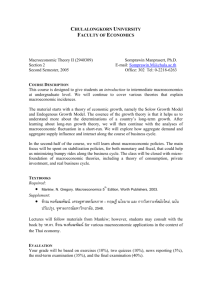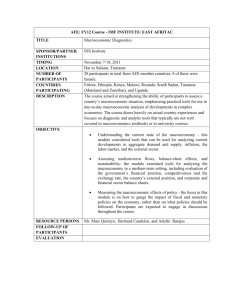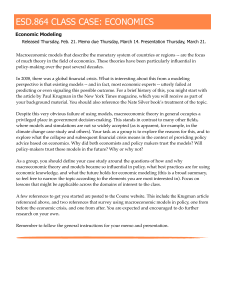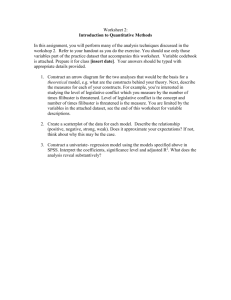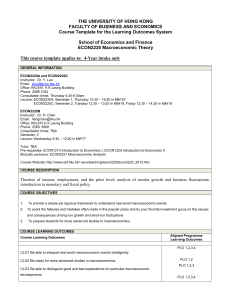Note on Analyzing Business Environments Global Markets Spring 2003
advertisement
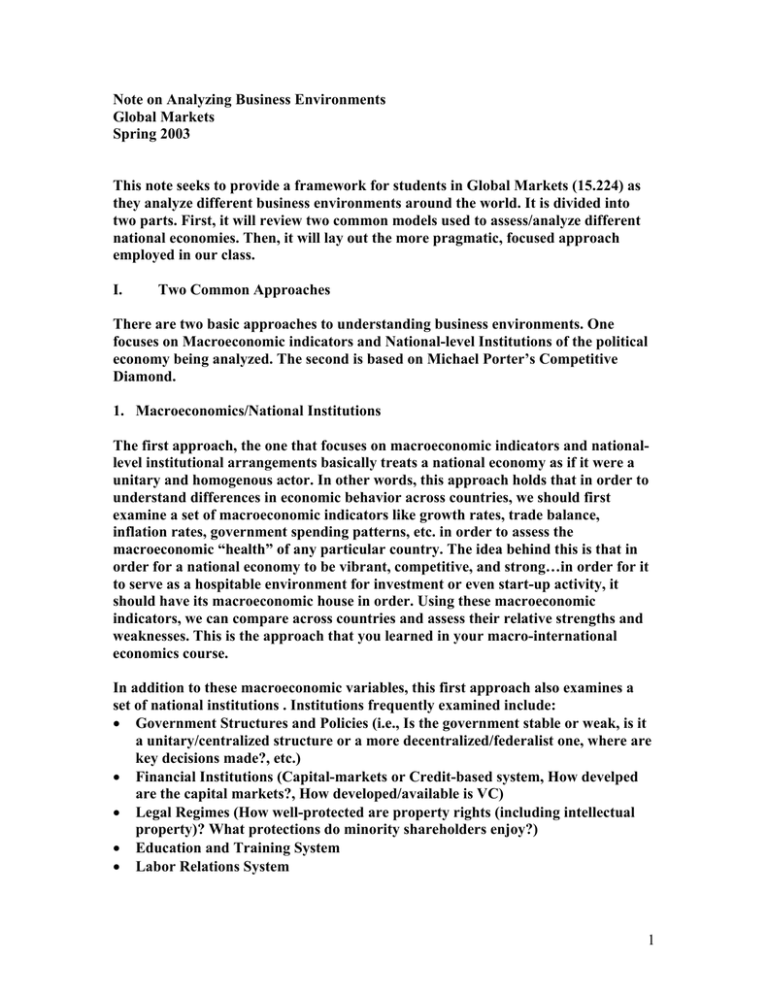
Note on Analyzing Business Environments Global Markets Spring 2003 This note seeks to provide a framework for students in Global Markets (15.224) as they analyze different business environments around the world. It is divided into two parts. First, it will review two common models used to assess/analyze different national economies. Then, it will lay out the more pragmatic, focused approach employed in our class. I. Two Common Approaches There are two basic approaches to understanding business environments. One focuses on Macroeconomic indicators and National-level Institutions of the political economy being analyzed. The second is based on Michael Porter’s Competitive Diamond. 1. Macroeconomics/National Institutions The first approach, the one that focuses on macroeconomic indicators and nationallevel institutional arrangements basically treats a national economy as if it were a unitary and homogenous actor. In other words, this approach holds that in order to understand differences in economic behavior across countries, we should first examine a set of macroeconomic indicators like growth rates, trade balance, inflation rates, government spending patterns, etc. in order to assess the macroeconomic “health” of any particular country. The idea behind this is that in order for a national economy to be vibrant, competitive, and strong…in order for it to serve as a hospitable environment for investment or even start-up activity, it should have its macroeconomic house in order. Using these macroeconomic indicators, we can compare across countries and assess their relative strengths and weaknesses. This is the approach that you learned in your macro-international economics course. In addition to these macroeconomic variables, this first approach also examines a set of national institutions . Institutions frequently examined include: • Government Structures and Policies (i.e., Is the government stable or weak, is it a unitary/centralized structure or a more decentralized/federalist one, where are key decisions made?, etc.) • Financial Institutions (Capital-markets or Credit-based system, How develped are the capital markets?, How developed/available is VC) • Legal Regimes (How well-protected are property rights (including intellectual property)? What protections do minority shareholders enjoy?) • Education and Training System • Labor Relations System 1 The reasons for layering an analysis of these institutions on top of the macroeconomic indicators is to see if a particular business environment has the “right” kinds of institutions to guarantee a healthy macro-economy and an attractive business environment. 2. Porter’s Diamond The second common approach focuses less on macroeconomic indicators or national-level institutional arrangements and much more on the micro-level factors that shape the competitiveness of particular industry clusters. Attached is a figure that outlines Porter’s model. The basic idea behind this model is that for us to understand the competitiveness of a particular industry cluster , we need to focus on how the Demand Factors, Supply Conditions, Structure, Strategy, and Rivalry of Firms, and the Existence of Related and Supporting Industries of a particular national economy create a hospitable environment for certain industries. Government policies, macroeconomic variables ,national institutional arrangements play a much less decisive role on this model. There exist benefits and deficits to both models. The first is too top-down, not sufficiently attentive to the internal heterogeneity of different national economies or even the different needs of different kinds of industries. The second is more careful about the micro-level factors shaping business activity but not sufficiently appreciative of the way national policies and institutions influence micro-level factors and conditions. II. The Need for a Synthesis In this class, we try to synthesize the best elements of the two above models but focus our attention particularly on those elements that are important for entrepreneurial activity. Thus, we begin with Porter’s Diamond but focus it on the particular business or sector we are interested in analyzing. How the Diamond in a particular country or region operates for say a biotech start-up may be very different than say for a software company. We need to be focused on the particular business/industry at hand. We also need to look for those factors listed in our earlier checklist. Beginning from there, we look at how the various macro-level factors (economic and non-economic alike) may influence the key points of the diamond in either positive or negative ways. This allows us to bring in relevant information about the macroeconomic or legal-political situation of a particular country so that it is actually useful to our analysis. 2 To help focus our analysis, we employ Baron’s 4 I heuristic: 1. 2. 3. 4. Issue Interests Institutions Information Together, these different approaches should enable us to focus on the kinds of data we need to collect to better understand different business environments. 3
